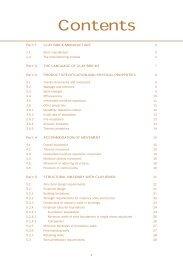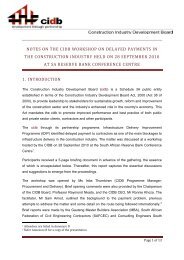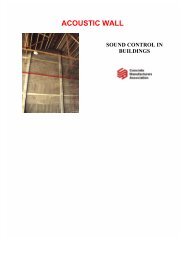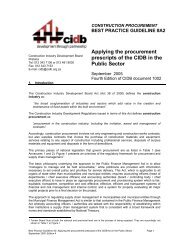MANUAL 4 - Construction Industry Development Board
MANUAL 4 - Construction Industry Development Board
MANUAL 4 - Construction Industry Development Board
Create successful ePaper yourself
Turn your PDF publications into a flip-book with our unique Google optimized e-Paper software.
<strong>MANUAL</strong> 4 – BITUMINOUS PAVEMENT SEALS<br />
A shovel of aggregate is taken. Then the aggregate is pitched into the air while twisting the<br />
shovel rapidly. This sprays the chips uniformly over the area to be covered. In this way the<br />
aggregate will fall onto the wet tack coat while the dust, if any, will fall onto the top of the<br />
aggregate or, if there is a breeze, will be blown across the road away from the surface.<br />
Once sufficient aggregate has been applied so that one can walk on the surface without<br />
coming into contact with the wet binder, the bare spaces can be filled with more stone.<br />
One labour unit can spread 4 3 105 litres of stone aggregate in one hour, i.e. the time taken<br />
to spray and cover 500 m 3 3,5 m of road.<br />
If spread by hand and 500 m sprays are to be covered, approximately 65 labour units are<br />
required to cover the spray in one hour.<br />
Using 180/200 pen. bitumen, the spray must be covered in less than half an hour.<br />
Using MC 3000 or MC 800, the spray must be covered in one hour.<br />
4.3.2 Application by a manually operated chip spreader<br />
Chip spreader<br />
The use of the Chippy hand spreader as (Photo 4.44) will facilitate the efficient uniform<br />
application of aggregate by hand labour and therefore, reduce the amount/intensity of<br />
brooming required.<br />
The Chippy which can be bought or hired from the company, has a capacity of three<br />
wheelbarrow loads of aggregate and is operated by four people – one to steer the Chippy<br />
and three to push it. The Chippy starts with a full load and spreads chips at a width of<br />
1,2 metres.<br />
Trial section<br />
Before any sealing is done with the Chippy, it must be adjusted for correct application by<br />
first doing dry runs on a clean, dry primed surface.<br />
Arrangements should be made with the manufacturer to train the operators of the Chippy<br />
in the correct method of operation, during the trial run and first operation on the bitumen<br />
binder.<br />
Application methodology<br />
As with the spreading of the aggregate by hand, predetermined quantities of the aggregate<br />
are spotted along the side of the road, using 105 litre half drums at distances determined by<br />
the engineer, depending on the grading and the application rate of the aggregate.<br />
When Chippies are used for spreading aggregate, the spotting of stone must be based on<br />
2 3 105 litres of stone per stockpile. This conveniently is the capacity of 3 wheelbarrows<br />
which also equals one fully loaded Chippy.<br />
One Chippy will work quite adequately when the binder is spread by a hand sprayer. If the<br />
binder is applied by a bulk distributor, as is the case here, it is recommended that three<br />
Chippies are used.<br />
Photo 4.48 depicts three chip spreaders being used at the same time. In this instance the<br />
procedure, as determined by the manufacturer, must be strictly followed.<br />
IMPLEMENTING EMPLOYMENT INTENSIVE ROAD WORKS 79<br />
MODULE<br />
1<br />
2<br />
3<br />
4<br />
5<br />
6<br />
7












